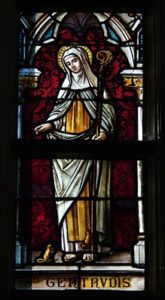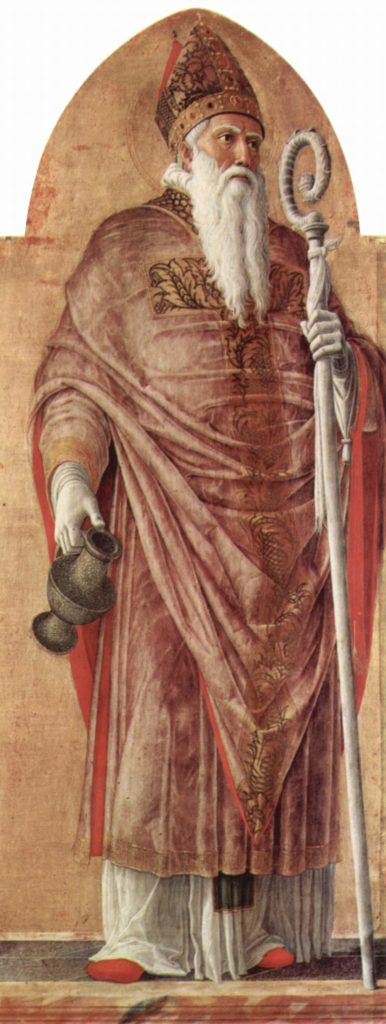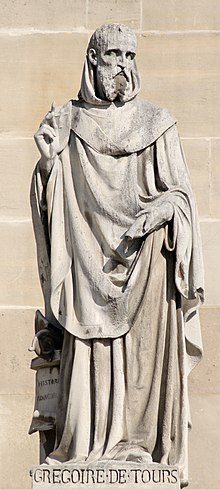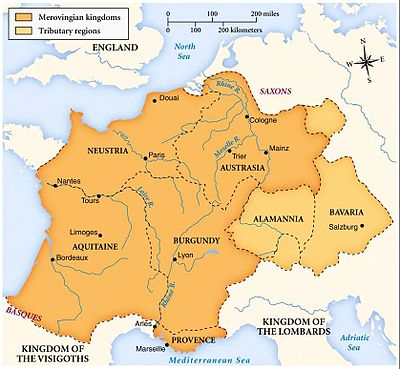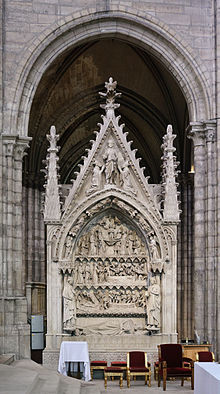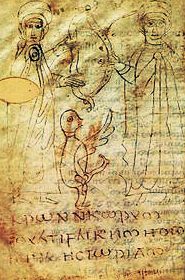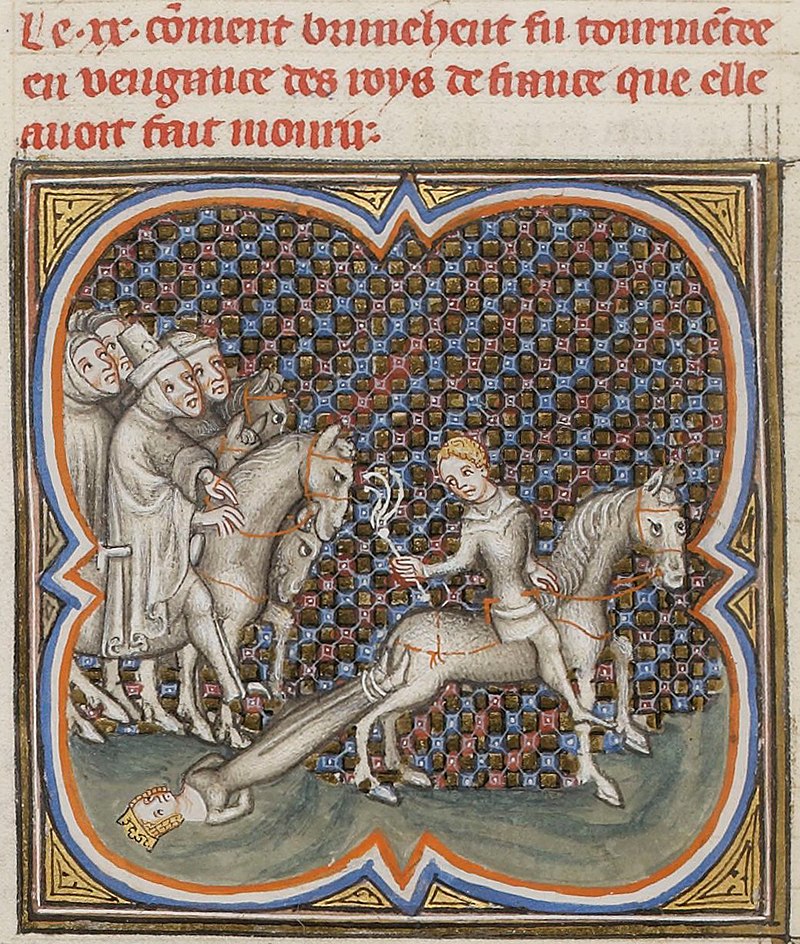– For the context of these translations click here –
The beatissimus dominus took care of women of ‘the tribe of the Angles’. His kinswoman Leoba, a whole generation younger than himself, he appointed abbess in the see of the archbishopric; Thecla, a relative of Leoba, he made abbess of Vitzingen and Ochsenfurt-on-the-Main. And all certainly for the great cause, the mission of all Germany, for the one whom Gregory III called ‘the apostle of the Germans’ (in reality: of Rome) and whom he appointed archbishop on a further journey to the Catholic capital (732), all for ‘the very advantageous business’ (talis commercii lucro) as is explicitly stated in such a context. Hence, the pope, with the whole Church, victoriously vindicated the apostle.
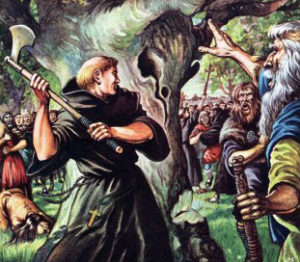 Of course, ‘business’ doesn’t mean the ‘pinch of silver and gold’ (argenti et auri tantillum), which Boniface occasionally donated to the holy father, but the conversion of ‘paganism and heterodoxy to the knowledge of the true faith’. From Hesse to Friesland he destroyed everywhere, ‘more as a conqueror than as a converter’ or missionary, the pagan places of worship, and on their ruins, with their very stones and timber, he erected Christian churches. He demolished the idols of Stuffo, Reto, Bil, the goddess Astaroth and so on. He tore down their altars, and felled the sacred trees in the Hessian forest, probably where, because they were under the direct protection of the Frankish fortress of Büraburg, they were in no personal danger, such as the oaks of Donar in Geismar, the tribal shrine, erecting with their wood a chapel to St. Peter, ‘his first sign of victory’ (Haller).
Of course, ‘business’ doesn’t mean the ‘pinch of silver and gold’ (argenti et auri tantillum), which Boniface occasionally donated to the holy father, but the conversion of ‘paganism and heterodoxy to the knowledge of the true faith’. From Hesse to Friesland he destroyed everywhere, ‘more as a conqueror than as a converter’ or missionary, the pagan places of worship, and on their ruins, with their very stones and timber, he erected Christian churches. He demolished the idols of Stuffo, Reto, Bil, the goddess Astaroth and so on. He tore down their altars, and felled the sacred trees in the Hessian forest, probably where, because they were under the direct protection of the Frankish fortress of Büraburg, they were in no personal danger, such as the oaks of Donar in Geismar, the tribal shrine, erecting with their wood a chapel to St. Peter, ‘his first sign of victory’ (Haller).
______ 卐 ______
Editor’s Note: It is these kinds of historical facts that have moved me in the past to obsess on this site about Game of Thrones. As no normie is going to study Deschner’s ten books, the most astute way to start conveying the most important facts of Aryan history is precisely novels in which these facts are alluded to fantastically, with castles, princesses and dragons. As we saw in past years with my countless entries on the TV series Game of Thrones, in the universe of novelist George R.R. Martin the fanatics of the new religion felled the sacred trees of Westeros.
This is the language the normie understands, and it’s a shame that the Jews who directed both Game of Thrones and the new prequel that has just been released betray fundamental facts of Martin’s prose. In a world where real Aryans took Martin to television, these outrages of the new religion perpetrated on the sacred trees of the old religion could be filmed in such a way that the message would be inspiring to whites.
______ 卐 ______
But Boniface also had to see no less than thirty churches and chapels destroyed in Thuringia. In Rome, however, the apostle didn’t only fight paganism, but at least as much, and probably even more, the sort of Christianity which wasn’t obedient to Rome, as among the Bavarians and the Alamanni. That was the second and shorter, though more important, phase of his activity.
Bavaria, where Boniface reformed (739) the church with the help of duke Odilus, after his relations with Charles Martell had cooled, had already been Christianised much earlier, though not Romanised. Thus, Roman Christianity and the Scottish missionary, ‘the first ‘Von-Rom Movement’ (far from Rome!)’ (Behn), ‘clashed violently’ in Bavaria (Schieffer). But there and in Thuringia Boniface, at the behest of Gregory II, eliminated as far as possible the old Christianity which had developed without violence. He tried to wrest the communities from the successors of these ecclesiastics and, with the help of state power, to bring them unceremoniously under the pontifical yoke.
But the papal legate also and especially fought against the Frankish clergy, who had preserved their autonomy vis-à-vis Rome and whose reformer he had avoided, if not fought against. In 738 Gregory III therefore strongly recommended obedience to his man regarding the bishops of Bavaria and Swabia, and at the same time insisted: ‘You must detect, prevent and annihilate the pagan customs and doctrines of the Bretons who roam everywhere, or of false and heretical priests and all their depravities’.
Boniface, who met with the ‘fierce resistance’ of many freemen (Epperlein), who was rude in his foreign manners, had no compunction and always went about with a large retinue; he was as obliging as they could wish for in Rome and more papist than the pope. He never asked why; he simply had to obey, as he had been taught. He was in fact ‘the heir of the Roman Church in England’ (Lortz).
The ‘apostle of the Germans’ was so unsure of his faith and so imbued for life with his tendency to sin, that he continually sent real questionnaires to Rome ‘as if we were kneeling at your feet’, to receive answers to the supreme questions of conscience.
Gregory II, who on 22 November 726 calmed his apostle’s eagerness to ask questions, let him know ‘the position in our Church’. An example: if parents have already deposited their sons or daughters ‘within the walls of the monastery’ (inter septa monasterii) at an early age, under no circumstances may they later leave the monastery and marry. ‘We strictly forbid it, because it is a sin to loosen the reins of pleasure on children, who were consecrated to God by their parents’. What barbarism beats in that answer, or behind this one: ‘You have also asked the question whether, when a contagious disease or mortality invades a church or a monastery, those who haven’t yet been affected can flee from that place to avoid the danger. That seems utterly foolish, for no one can escape the hand of God’ This rhetoric has not always, but quite often in everyday practice, been a function of minimisation, discharge and beautification. Theologians and historians, thanks to their phrase ‘link to the times’, don’t need to call the crimes and criminals of the Church and the State crimes and criminals.
Those were times when some served two sides, attended the Christian liturgy and at the same time offered sacrifices to Wotan; they ‘ate bulls and goats sacrificed to the pagan gods’, which could in no way harm either Christ or Wotan.


